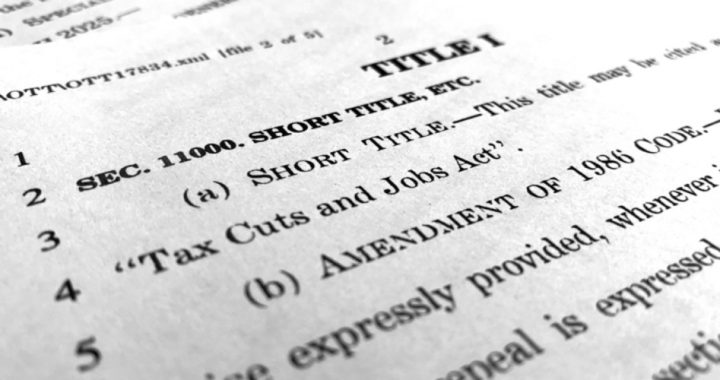
Tax cuts benefit the rich because they are the ones who pay the bulk of the income taxes collected, and always have.
The Republicans’ tax-reform bill that President trump signed into law before Christmas (H.R.1, PL 115-97) has Democrats fuming. The final version of the Tax Cuts and Jobs Act passed the Senate by a vote of 51-49. It passed the House by a vote of 224 – 201, with 12 Republicans voting against the measure. There are 10 Democrats in the Senate running for reelection in states that President Trump won last year. Not a single one of those senators voted in favor of the tax bill. In fact, no Democrat in the Senate or the House voted for the tax bill.
Briefly, the Tax Cuts and Jobs Act revises the seven current tax brackets of 10, 15, 25, 28, 33, 35, 39.6 percent to 10, 12, 22, 24, 32, 35, and 37 percent. It increases the threshold for landing in the top bracket to $500,000 ($600,000 married filing jointly). It eliminates the personal exemption, but establishes a temporary $500 nonrefundable credit for non-child dependents. It increases the standard deduction from $6,500 (single filers), $9,550 (heads of households), and $13,000 (married filing jointly) to $12,000, $18,000, and $24,000, respectively. It doubles the child tax credit from $1,000 to $2,000. It effectively repeals the ObamaCare individual mandate penalty by lowering the penalty amount to $0 (effective January 1, 2019). It raises the exemption on the alternative minimum tax to $70,300 ($109,400 for married filing jointly) and increases the phase-out threshold to $500,000 ($1 million for married filing jointly). It doubles the estate tax exemption from $5.6 million to $11.2 million, indexed to inflation. It retains the charitable contribution deduction, but limits the mortgage interest deduction to the first $750,000 in principal value and the state and local tax deduction to a combined $10,000 for income, sales, and property taxes. It also limits or eliminates some other deductions.
The Tax Cuts and Jobs Act lowers the maximum corporate income tax rate from 35 to 21 percent. And, as concerning business-related items that directly affect individuals, it establishes a 20 percent deduction of qualified business income from certain pass-through businesses, allows full and immediate expensing of short-lived capital investments for five years, and doubles the Section 179 expensing cap from $500,000 to $1 million.
The Tax Foundation estimates that Tax Cuts and Jobs Act will “increase the long-run size of the U.S. economy by 1.7 percent,” resulting in “1.5 percent higher wages,” a “4.8 percent larger capital stock,” and “339,000 additional full-time equivalent jobs.”
Democrats, predictably, are complaining that the GOP tax cuts benefit the rich instead of the middle class. Democratic National Committee Chairman Tom Perez described the tax bill as a “massive tax break bill for large corporations and for uber-wealthy people.” “Instead of providing a tax cut that overwhelmingly benefits the middle class, this bill cuts taxes for the wealthiest Americans while raising taxes on a majority of families making less than $75,000 in the coming years,” said Senator Joe Donnelly (D-Ind.) on the Senate floor. “This tax plan doesn’t live up the commitment I got from President Trump, when he told me he wouldn’t support tax reform that benefited the very rich at the expense of the little guy,” added Senator Claire McCaskill (D-Mo.).
But of course tax cuts benefit the rich. They are the ones who pay the bulk of the income taxes collected, and always have.
The income tax began with a 1 percent tax on taxable income above $3,000 ($4,000 for married couples) followed by a series of surcharges of up to 6 percent applied to higher incomes. The maximum rate of 7 percent was applied to taxable income over $500,000. The top rate has fluctuated widely over the years, and was near or above 90 percent from 1950–1963.
According to IRS data from 2014 — the most recent year available — 139,562,034 tax returns were filed reporting $9.71 trillion in adjusted gross income (AGI). Taxpayers paid $1.37 trillion in individual income taxes in 2014, an 11.5 percent increase from the previous year. The top 0.1 percent of taxpayers (in terms of AGI) paid 19.85 percent of all federal income taxes. The top 1 percent paid 39.48 percent. The top 5 percent paid 59.97 percent. The top 10 percent paid 70.88 percent. The top 25 percent paid 86.78 percent. And the top 50 percent paid 97.25 percent. This means that the bottom 50 percent of taxpayers (those with AGIs below $38,173) paid just 2.75 percent of all federal income taxes. It also means that the top 1 percent of taxpayers paid about as much as the bottom 95 percent.
“The rich” are also punished through the phase-out of tax exemptions, deductions, and credits as income rises, even as “the poor” receive tax refunds from the government of money they never paid in via refundable tax credits.
The solution to this injustice is not to make the tax code simpler or flatter. And neither is it to make “the poor” pay their “fair share.” The solution is to limit government spending to only that which is authorized by the Constitution and eliminate the need for an income tax in the first place.
Photo: AP Images



